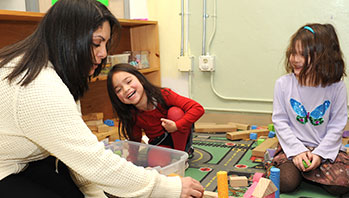- children's rubber band guitars (from Discovery Time)
- instrument
- sound
MA Standards:
Speaking and Listening: SL.PK.MA.1a Observe and use appropriate ways of interacting in a group (e.g., taking turns in talking, listening to peers, waiting to speak until another person is finished talking, asking questions and waiting for an answer, gaining the floor in appropriate ways).
MA Draft STE Standards:
Physical Sciences/Energy and PS4/PS4.B Apply their understanding in their play of how to change the volume and pitch of some some sounds.
Head Start Outcomes:
Social Emotional Development/Self-Regulation Follows simple rules, routines, and directions.
Language Development/Receptive Language Attends to language during conversations, songs, stories, or other learning experiences.
PreK Learning Guidelines:
English Language Arts/Language 1 Observe and use appropriate ways of interacting in a group (taking turns in talking; listening to peers; waiting until someone is finished; asking questions and waiting for an answer; gaining the floor in appropriate ways).
English Language Arts/Reading and Literature 12 Listen to, recite, sing, and dramatize a variety of age-appropriate literature.
Play Together: “Show Us What Your Instrument Can Do”

© Commonwealth of Massachusetts, Department of Early Education and Care (Jennifer Waddell photographer). All rights reserved.
STEM Key Concepts: Different objects make different sounds; Sounds vary in three ways: volume (loud or soft), pitch (high or low), and timbre (quality); A sound becomes louder when the force of the action that is creating the sound is increased
Gather children in a circle in the Pretend and Play Center with their rubber band instruments. Sing the first verse of the song “Show Us What Your Instrument Can Do” and have one child demonstrate making a sound. Then sing the second verse of the song, and have everyone try to create the same sound. Go around the circle until everyone has had a turn creating a sound.
Show Us What Your Instrument Can Do
Hello, <child’s name>. How are you?
Show us something your instrument can do.
This is what <child’s name>’s instrument can do.
I think we can all do it, too!
Social Emotional Tip: After children have performed, ask them to name something they liked about each other’s sounds.
